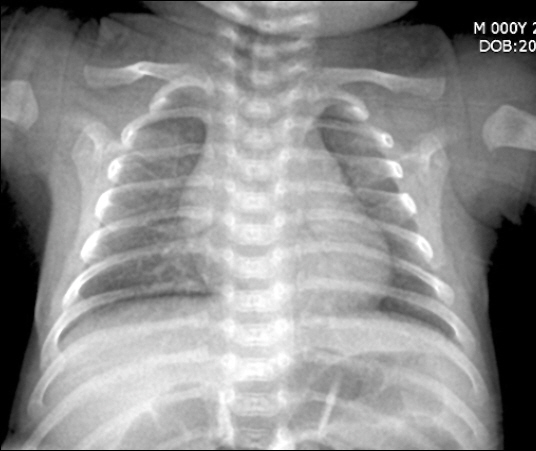Anesth Pain Med.
2017 Apr;12(2):147-150. 10.17085/apm.2017.12.2.147.
Airway obstruction during general anesthesia in a premature infant suspecting bronchospasm and/or airway malacia: A case report
- Affiliations
-
- 1Department of Anesthesiology and Pain Medicine, Yeungnam University College of Medicine, Daegu, Korea. hmlee@yu.ac.kr
- KMID: 2379735
- DOI: http://doi.org/10.17085/apm.2017.12.2.147
Abstract
- Airway management is challenging during general anesthesia particularly in small infants. Airway obstruction is prone to occur in premature infants during general anesthesia due to several reasons. We report a case of airway obstruction occurred during the induction of general anesthesia in a 2-month-old infant. Several attempts at endotracheal intubation with positive pressure ventilation resulted in repeated patterns of no end-tidal carbon dioxide output after each trial of endotracheal intubation, but it was reappeared after extubation. However, anesthetic induction with self-respiration and gentle assistance with manual bagging led to a successful intubation. This case was explained by hydromechanics in a collapsible premature airway.
Keyword
MeSH Terms
Figure
Reference
-
1. Westhorpe RN, Ludbrook GL, Helps SC. Crisis management during anaesthesia:bronchospasm. Qual Saf Health Care. 2005; 14:e7. DOI: 10.1136/qshc.2002.004457. PMID: 15933304. PMCID: PMC1744001.2. Dewachter P, Mouton-Faivre C, Emala CW, Beloucif S. Case scenario:bronchospasm during anesthetic induction. Anesthesiology. 2011; 114:1200–10. DOI: 10.1097/ALN.0b013e3182172cd3. PMID: 21460703.3. Masters IB, Chang AB, Patterson L, Wainwright C, Buntain H, Dean BW, et al. Series of laryngomalacia, tracheomalacia, and bronchomalacia disorders and their associations with other conditions in children. Pediatr Pulmonol. 2002; 34:189–95. DOI: 10.1002/ppul.10156. PMID: 12203847.4. Schwartz MZ, Filler RM. Tracheal compression as a cause of apnea following repair of tracheoesophageal fistula:treatment by aortopexy. J Pediatr Surg. 1980; 15:842–8. DOI: 10.1016/S0022-3468(80)80290-9.5. Blair GK, Cohen R, Filler RM. Treatment of tracheomalacia:eight years’ experience. J Pediatr Surg. 1986; 21:781–5. DOI: 10.1016/S0022-3468(86)80366-9.6. Ahel V, Banac S, Rozmanić V, Vukas D, Drescik I, Ahel VA Jr. Aortopexy and bronchopexy for the management of severe tracheomalacia and bronchomalacia. Pediatr Int. 2003; 45:104–6. DOI: 10.1046/j.1442-200X.2003.01660.x. PMID: 12654081.7. Han J, Kim C, Lee SH, Burm J. Complete endotracheal tube obstruc tion with mucus during anesthesia in a child with upper respiratory tract infection :a case report. Anesth Pain Med. 2007; 2:82–4.8. Choi YJ, Choi SU, Cho EJ, Oh JY, Lim HJ. Severe bronchospasm in a premature infant during induction of anesthesia caused ventilation failure. Korean J Anesthesiol. 2013; 65(6 Suppl):S84–6. DOI: 10.4097/kjae.2013.65.6S.S84. PMID: 24478886. PMCID: PMC3903874.9. Hysinger EB, Panitch HB. Paediatric tracheomalacia. Paediatr Respir Rev. 2016; 17:9–15. DOI: 10.1016/j.prrv.2015.03.002. PMID: 25962857.10. Tanphaichitr A, Tanphaichitr P, Apiwattanasawee P, Brockbank J, Rutter MJ, Simakajornboon N. Prevalence and risk factors for central sleep apnea in infants with laryngomalacia. Otolaryngol Head Neck Surg. 2014; 150:677–83. DOI: 10.1177/0194599814521379. PMID: 24493785.11. Doyle DJ, O’Grady KF. Hagberg CA, editor. Physics and modeling of the airway. Benumof and Hagberg’s Airway Management. 2012. 3rd ed. Philadelphia: Mosby Elsevier;p. 92–117. PMID: 22794052.12. Kwon YS, Lim YH, Park HL, Yoo BH, Woo SH, Yon JH. Reversible airway obstruction caused by changing the size and length of an endotracheal tube in a premature neonate with suspected tracheomalacia -A case report-. Korean J Anesthesiol. 2010; 59(Suppl):S30–2. DOI: 10.4097/kjae.2010.59.S.S30. PMID: 21286454. PMCID: PMC3030050.13. Asai T, Shingu K. Airway obstruction in a child with asymptomatic tracheobronchomalacia. Can J Anaesth. 2001; 48:684–7. DOI: 10.1007/BF03016204. PMID: 11495877.
- Full Text Links
- Actions
-
Cited
- CITED
-
- Close
- Share
- Similar articles
-
- Noncardiogenic Pulmonary Edema Related to Airway Obstruction
- A Case of Anesthetic Management for Moderate Tetanus
- Reversible airway obstruction caused by changing the size and length of an endotracheal tube in a premature neonate with suspected tracheomalacia: A case report
- Intraoperative airway obstruction caused by dissection of the internal wall of a reinforced endotracheal tube: A case report
- Airway obstruction in heat & moisture exchanger filter: A case report


